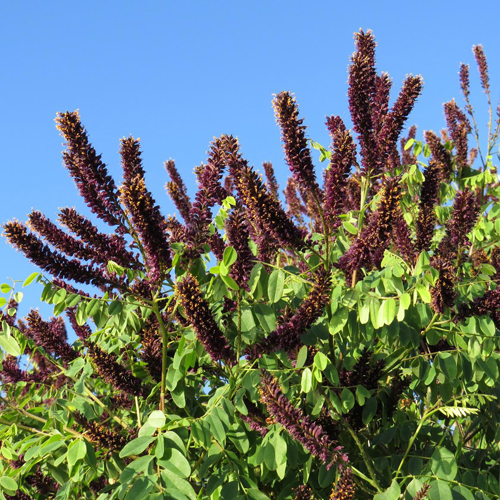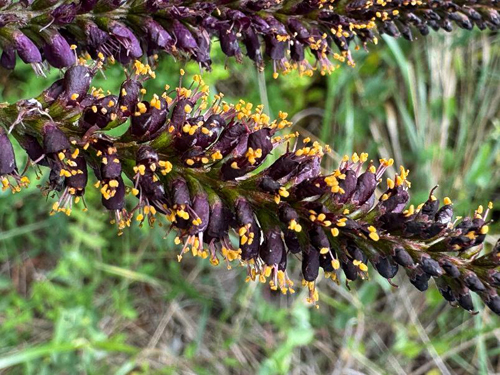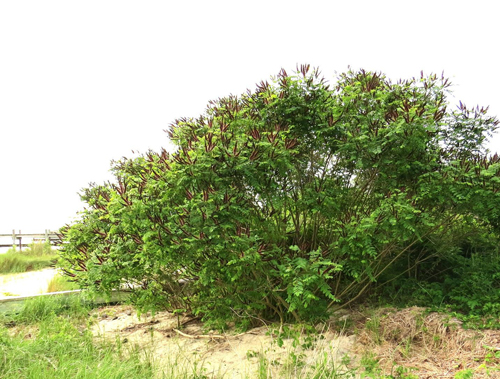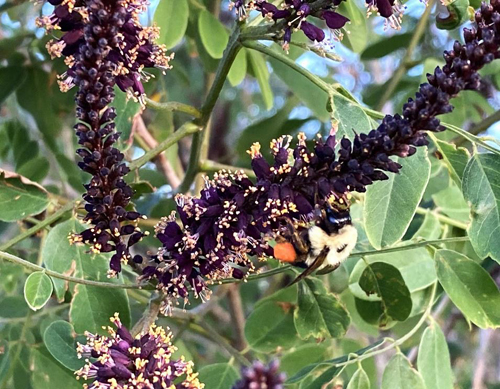False Indigo-bush, Amorpha fruticosa
By Betsy Washington, Northern Neck Native Plant Society
As May comes into bloom, I always look forward to the flowers on my False Indigo-bush that graces my upper shoreline. I inherited this lovely deciduous shrub when I bought this property and count myself lucky to have this amazing shrub that is beautiful yet tolerates dry, sterile sandy soil and handles occasional flooding from high tides, wind, heat, you name it! I had long admired a False Indigo-bush that grows wild in the dunes just above the beach at nearby Hughlett Point Natural Area Preserve so I am overjoyed to have one on my own property.

False Indigo-bush is literally covered in showy violet racemes in May; photo: Betsy Washington
Each May this 4 – 12’ high shrub erupts into spectacular showy racemes of vanilla-scented, deep violet to purple-blue flowers held in dramatic upright spike-like clusters at the tips of the branches. Each raceme averages 3 – 8” long creating an impressive show. Look closely and you can see that each small tubular flower is quite unusual for a legume with a single petal that wraps around the reproductive parts. The 10 stamens extend well past the petal (strongly exserted) and are topped with showy bright yellow-orange anthers that stand out against the deep violet blooms. The flowers last for a couple of weeks and are followed later in summer by small tan warty capsules, each with 1 or 2 seeds.

Distinctive tubular flowers with exserted stamens; photo: Betsy Washington
The fine-textured, pinnately compound leaves are distinctive themselves and tend to be concentrated in the upper half of the shrub giving it a loose, airy appearance. The soft gray-green foliage compliments the intensely colored flowers and take on reddish-gold tints in fall. The leaves are covered with tiny resin glands and deter herbivores. The lower smooth grayish-brown stems are woody and a create a handsome contrast with the airy foliage.
This adaptable shrub is found naturally on the banks of streams and ponds, along the edges of marshes, in alluvial shrub thickets, and along the sedimentary cliffs of our Coastal Plain rivers. The Flora of Virginia describes it as “infrequent and scattered” in the Coastal Plain and Piedmont, and rare in the mountains.
False Indigo-bush typically grows in full sun to part shade and although it prefers light, well drained, sandy soils, it is very tolerant of a range of soils including clay. As mentioned, it tolerates occasional flooding as well as droughts. This is a member of the Legume or Pea Family and as such, has symbiotic bacteria in nodules on their roots that “fix” atmospheric nitrogen allowing the plants to grow in extremely poor, sterile soils. They can spread by suckers or seeds and often form dense thickets making it an excellent choice for stabilizing riparian buffers and creating wildlife habitat. Older specimens are often wider than tall and look great planted in masses or as shelterbelts, just as they often grow in nature. They have no serious insect or disease problems and are sometimes touted as being “immune to insect pests.” As an additional bonus, they are resistant to deer and other herbivores. Some have written that False Indigo-bush is not tolerant of salt, but my large specimen has been thriving on my upper sandy shoreline where it is occasionally flooded by brackish high tides and exposed to salt spray for years. This makes it a splendid and showy upper shoreline plant.

This adaptable shrub is often wider than tall and is an ideal shoreline stabilizer; photo: Betsy Washington
The common name, False Indigo-bush, alludes to its use as a dye that produces an indigo pigment. It has also been used as a natural insecticide and insect repellent. The fragrant nectar-rich flowers attract a variety of small to medium sized bees like Sweat, Miner, and Little Carpenter Bees as well as a specialist miner bee, Andrena quintilis. It is also a host plant for the caterpillars of the Silver-spotted and Hoary Edge Skippers, Dogface Sulphur, Gray Hairstreak, and Black-spotted Prominent Moth. It produces copious amounts of small seeds that are favored by a variety of seed-eating birds such as Bobwhite, sparrows, and Blue Grosbeaks.

Nectar-rich flowers attract a variety of pollinators; photo: Betsy Washington
This under-utilized shrub has it all – a tough constitution and extreme adaptability, along with spectacular May flowers, and high wildlife value that will bring birds, pollinators, and butterflies to your garden. Tolerant of wind, cold, heat, and resistant to pests and herbivores, this shrub surely belongs in more gardens, including yours!
False Indigo-bush is the Northern Neck Native Plant Society May 2025 Plant of the Month.

Hi, I planted a bare root false indogo bush in Northern VA a couple of years ago and it it’s a very very leggy tree-like specimen. It has leaves and flowers this year — but only at the very top of it. It doesn’t even appear to have bark or any place branches were growing. …Very tall now, maybe 5 feet or more feet, and not a single branch coming from it. Is it the soil (heavy clay)? Lack of light (it’s growing in shade)? Damage, perhaps? (a deer entered our yard once but I don’t see any rub). Is there Any hope for it?
I read about your group on another site. I’m in Wisconsin zone 5 and I love be the baptisia but it flops right open in the middle! Why might this happen? The bees are still loving it